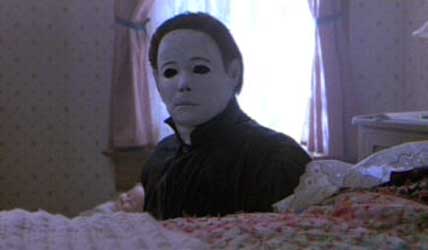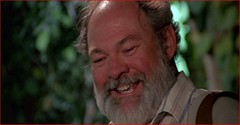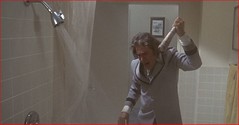
With our first baby on the way, I've been doing some soul searching about kids movies. On one hand I'll love watching Toy Story or Willy Wonka for the first time with my child, but I'll also silently dread having to brave a Shrek movie. Of course, I'll wean the child on my (appropriate) favorites from Day 1, but there will be many times when a kids movie has to be put on. I've thought a lot about the unorthodox diet of movies that comprised much of my youth, which was usually HBO and whatever I could convince my parents to rent. I can't tell you how many memories of nameless movies from HBO I have, and most of them I'll probably never see again. But I was finally able to re-view one of those random crazy 2 p.m.-on-a-Sunday movies this week, thanks to Google Video.
Joseph B brought it to my attention that The Peanut Butter Solution was online in its entirety, which was kind of amazing since it's not on DVD anywhere. Peanut Butter was a movie I watched in fragments many times, and for quite awhile I wasn't sure if my memories of it were real or dreamed. The IMDB comments for the movie confirm that many other people felt the same way. Watching it again, I think it's holds up very well as a kids movie, and I think my kid will be the only one in the schoolyard trying to explain the art of magic paintbrushes.
Yes, magic paint brushes. And ghosts, and kids enslaved by a mad art teacher, and a kid with a lot of hair. A truly strange movie, The Peanut Butter Solution's best plot device happens early, when young Michael finds his way into a burnt out house and is mysteriously frightened to such a degree that he goes bald. Michael can't remember what it was that scared him so much, but he does know that he can't go on with his life without any hair. Luckily, a couple of hobos died and became ghosts and they want to help Michael with his problem. They know about a concoction that will regrow hair -- just don't put too much peanut butter in it. Of course, Michael does put too much peanut butter in, and soon he has Cousin It hair growing at an astonishing rate. If that's not bad enough, he soon gets kidnapped by an art teacher he didn't like who imprisons him in a factory run by enslaved children where his hair can be farmed to create magic paint brushes. Yup, this movie has it all.
Peanut Butter freaked me out as a kid, and it is genuinely creepy, considering its intended audience. The idea that something could scare you so much as to force baldness is a chilling concept for a child, and the movie sells the idea well by having it be unexplained until the end. And kidnapping, especially in the 80s when it seemed every kid was convinced their captor could be lurking behind the nearest tree, is always a gruesome concept for kids and even more so when it involves a hated teacher. The magic paintbrushes made from Michael's enchanted hair allow a person to paint a picture that they can "enter" and interact with, and the low budget effects do a good job of portraying this concept. Unfortunately, when the culprit of Michael's fright is revealed at the end, it's an unquestioned letdown -- probably due to an equal lack of writing creativity and budget constraints.
Released in 1985, the Canadian production of The Peanut Butter Solution was the second in director Rock Demers' Tales for All series, and by far the most popular. Apparently, Demers was an influential figure in Quebec's emerging film industry in the 1970s:
Throughout the 1970s, Quebec quietly established itself as the centre of production for Canadian children's films. The success of 1970's The Christmas Martian spawned such venerable kiddie fare as Jacob Two Two Meets the Hooded Fang (1972) and Mystery of the Million Dollar Hockey Puck (1976), but it wasn't until the 1980s that the industry became one of the cornerstones of Canadian b-film production, thanks primarily to the efforts of one man? Rock Demers.No offense to my Canadian readers, but that paragraph reads like something out of a Christopher Guest script. The Christmas Martian? Jacob Two Two Meets the Hooded Fang? Wow. The Peanut Butter Solution sounds pretty normal compared to those titles. Another bit of trivia: this movie featured the English language debut of one Celine Dion! So if you have 90 minutes to spare, click below and enjoy this odd Canadian 80s kids flick.
































